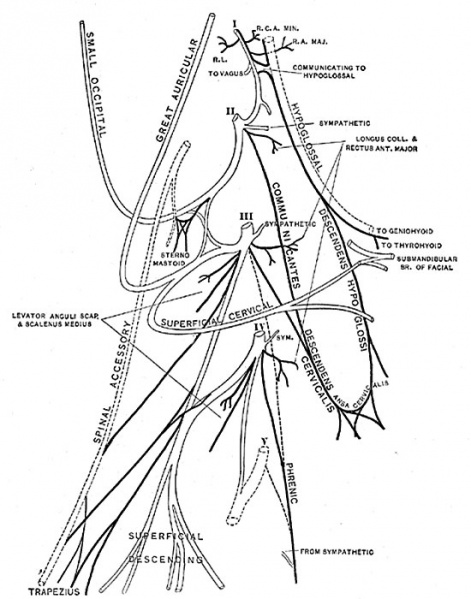File:Gray0804.jpg

Original file (550 × 700 pixels, file size: 75 KB, MIME type: image/jpeg)
The Cervical Plexus (plexus cervicalis)
(plexus cervicalis) Plan of the cervical plexus. (Gerrish.)
The cervical plexus is formed by the anterior divisions of the upper four cervical nerves; each nerve, except the first, divides into an upper and a lower branch, and the branches unite to form three loops. The plexus is situated oppostie the upper four cervical vertebræ, in front of the Levator scapulæ and Scalenus medius, and covered by the Sternocleidomastoideus.
Its branches are divided into two groups, superficial and deep, and are here given in tabular form; the figures following the names indicate the nerves from which the different branches take origin.
The Phrenic Nerve
(C3-C5) (n. phrenicus; internal respiratory nerve of Bell) contains motor and sensory fibers in the proportion of about two to one. It arises chiefly from the fourth cervical nerve, but receives a branch from the third and another from the fifth; (the fibers from the fifth occasionally come through the nerve to the Subclavius.) It descends to the root of the neck, running obliquely across the front of the Scalenus anterior, and beneath the Sternocleidomastoideus, the inferior belly of the Omohyoideus, and the transverse cervical and transverse scapular vessels. It next passes in front of the first part of the subclavian artery, between it and the subclavian vein, and, as it enters the thorax, crosses the internal mammary artery near its origin. Within the thorax, it descends nearly vertically in front of the root of the lung, and then between the pericardium and the mediastinal pleura, to the diaphragm, where it divides into branches, which pierce that muscle, and are distributed to its under surface. In the thorax it is accompanied by the pericardiacophrenic branch of the internal mammary artery.
The two phrenic nerves differ in their length, and also in their relations at the upper part of the thorax.
- Gray's Images: Development | Lymphatic | Neural | Vision | Hearing | Somatosensory | Integumentary | Respiratory | Gastrointestinal | Urogenital | Endocrine | Surface Anatomy | iBook | Historic Disclaimer
| Historic Disclaimer - information about historic embryology pages |
|---|
| Pages where the terms "Historic" (textbooks, papers, people, recommendations) appear on this site, and sections within pages where this disclaimer appears, indicate that the content and scientific understanding are specific to the time of publication. This means that while some scientific descriptions are still accurate, the terminology and interpretation of the developmental mechanisms reflect the understanding at the time of original publication and those of the preceding periods, these terms, interpretations and recommendations may not reflect our current scientific understanding. (More? Embryology History | Historic Embryology Papers) |
| iBook - Gray's Embryology | |
|---|---|

|
|
Reference
Gray H. Anatomy of the human body. (1918) Philadelphia: Lea & Febiger.
Cite this page: Hill, M.A. (2024, April 23) Embryology Gray0804.jpg. Retrieved from https://embryology.med.unsw.edu.au/embryology/index.php/File:Gray0804.jpg
- © Dr Mark Hill 2024, UNSW Embryology ISBN: 978 0 7334 2609 4 - UNSW CRICOS Provider Code No. 00098G
File history
Click on a date/time to view the file as it appeared at that time.
| Date/Time | Thumbnail | Dimensions | User | Comment | |
|---|---|---|---|---|---|
| current | 10:25, 9 February 2016 |  | 550 × 700 (75 KB) | Z8600021 (talk | contribs) | |
| 12:26, 1 May 2011 |  | 600 × 764 (73 KB) | S8600021 (talk | contribs) | ==The Cervical Plexus (plexus cervicalis)== Plan of the cervical plexus. (Gerrish.) The cervical plexus is formed by the anterior divisions of the upper four cervical nerves; each nerve, except the first, divides into an upper and a lower branch, and t |
You cannot overwrite this file.
